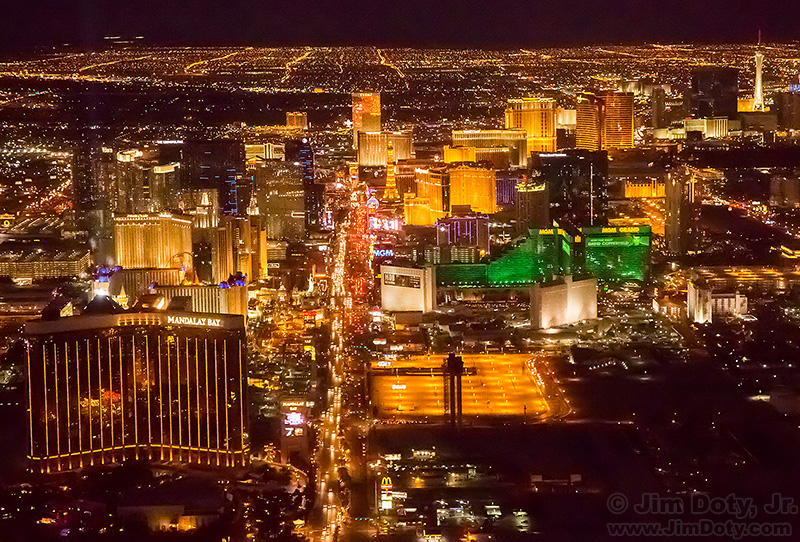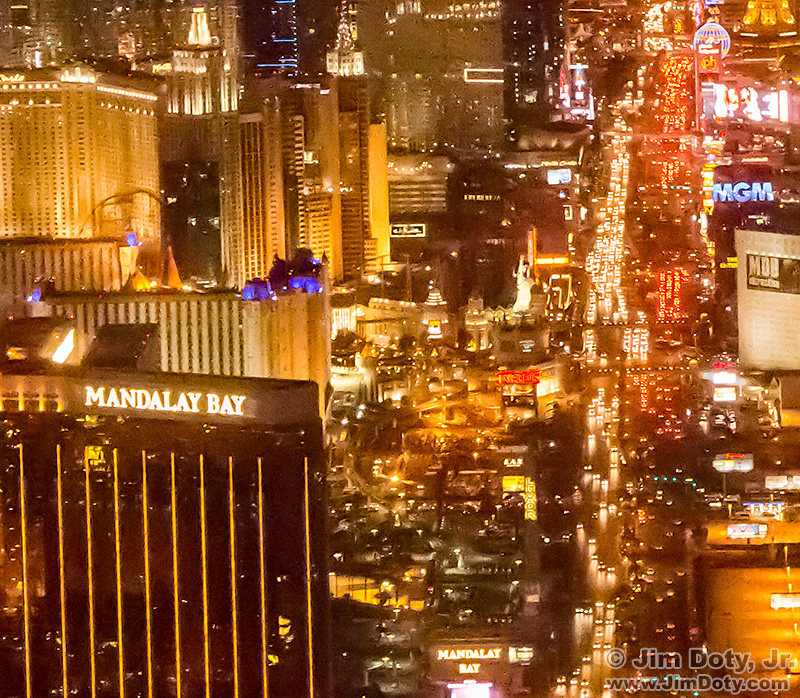There are serious challenges to photographing city lights at night from a commercial jet. Here are some suggestions that will help.
The first and biggest challenge is the speed of the jet. They generally take off at 150-200 mph and continue to gain speed after take off. That means fast shutter speeds or you will have blurred lights. Motion freezing shutter speeds depend on the focal length of the lens, the distance to the subject, and the speed of the subject. (It also depends on the size of the sensor but that isn’t a variable you can change unless cameras with different sized sensors.)
In this case, freezing the ground from a jet (stopping the motion) is no different than freezing a jet from the ground, provided the distance and focal length are the same. In my experience you will need a shutter speed around 1/200 seconds with a lens focal length in the 50-75mm range.
The next challenge is the low light levels of city lights at night. This means high ISO settings and wide lens apertures. When I am shooting city lights at night from the ground, it isn’t uncommon for me to set the ISO to 100 and use shutter speeds of 8 to 15 seconds or longer. That won’t work from the air (unless you happen to want blurred lights). So ideally you will have fast lenses and a camera with high ISO speeds.
The best lenses to use in these conditions are prime (single focal length) lenses with fast maximum apertures like f/1.4, f/2, or f/2.8. Unfortunately, I was using a zoom lens with a maximum aperture of f/4. That is pretty slow of aerial photography at night. In addition, whatever lens you use you should stop it down about one stop from the maximum aperture to minimize lens aberrations. I was shooting at f/5.
Manually focus the lens on infinity, or autofocus on something far away and then turn the autofocus off.
With a fast shutter speed of 1/200 second and an aperture of f/5, a really high ISO is called for to get a good exposure. I needed to use an ISO around 12800 or 25600. With a fast lens and an aperture of f/2.8, I could have dropped the ISO to a more reasonable 3200 or 6400.
High ISO settings mean lots of digital noise. RAW files are best in for high ISO situations and they can be processed with Adobe Camera Raw (ACR) to reduce much of the luminance noise. In the photo immediately above (cropped from the photo at the top), you can see some of the digital noise that is left in the image, even after removing a lot of luminance noise with ACR. The good news is that the Canon 5D Mark III is one of the best current cameras when it comes to digital noise at high ISO settings.
Pick a window seat with a clean, unscratched window that is in front of the wing and engines. The wing will block your view if you sit over a wing, and engine exhaust will blur your photos if you sit behind the engines. You can pick your seat ahead of time with most airlines, but you have no idea what kind of window you will get. I usually fly Southwest, I board early, and I check the windows as I go down the aisle. Sometimes you don’t have a good choice. I was lucky on this flight. We were on a brand new, Boeing 737-800 with nice, new, clean, unscratched windows.
Vibrations from the plane can blur your photos, so use your body as a shock absorber between the camera and the plane. Don’t touch the camera to the window and don’t let your elbows touch the arm rest or side of the plane. Get as close to the window as you can but do your best to let your upper body “float free” of contact with the plane.
At night, reflections from the cabin can show up in your photos as they bounce off the window surfaces. Use a jacket or sweater with a black or dark lining and put it over yourself and the camera (like photographers used to do with a dark cloth over a large format camera). The dark lining won’t reflect in the window and will block other light reflections. Get your camera lens as close to the window as possible without touching the window. Yes, you will look strange under the jacket or sweater. It helps to travel with a companion that understands your photographic oddities.
Take your pictures before you get too high in elevation. This usually means shortly after take off or before the landing. You will get less distortion from the window if you shoot slightly down through the window surfaces rather than down at a severe angle through the window surfaces. Shooting before you get too high helps you shoot at a better angle.
If you are curious, most aerial night photography of city lights is done from privately chartered small planes or helicopters which have a much slower air speed. That allows for slower shutter speeds and lower ISO settings. Not many of us charter private planes to take photos, but lots of us ride on commercial jets so make the most of the suggestions here.
Las Vegas is one of the best cities on the planet to photograph at night from the air because it is so bright, several stops brighter than most other cities. If you fly in and out of Las Vegas, try and book your departure flight in the evening or at night. The prevailing winds are usually out of the west. Sit on the right side of the plane so you can see the Las Vegas Strip to your right as the plane takes off heading west. This doesn’t always work but if you are betting on where to sit for a great photo, the odds are with sitting on the right side of the plane.
Photo Data: Canon 5D Mark III. Canon EF24-105mm f/4L lens at 70 mm. 1/200 sec, f/5.0, ISO 25600.
Link
To learn more about night and low light photography, cityscapes at night, apertures and ISO settings, read Digital Photography Exposure for Dummies. You can order it from Amazon.com.


